Levin also made guitars under a few other names, including "Klangola". I have both seen and renovated a few Klangolos over the years. They were specially ordered by Förlaget Filadelfia in Stockholm and had some extra options. The ones I've seen have had a wide side and a small sound hole with a wide zebra-striped rosette in celluloid in black and white. Also, most of them have a very ugly binding around the fingerboard which also is half black and half white. The wood in the guitar is always better, I think its maple in the bottom and sides on this one, but I have also seen flamed birch. The neck usually has a slightly more angular U shape, which is not that comfortable to play on. Most of the time the name is not found as a sticker on the head, but inside is a fancy black label with gold lettering. The bridge is of the "string through" type, like on a classical guitar.
This 1946 example was in good condition with a Gibson like sunburst on the top and also a black burst on the neck foot. No direct damage was found except for a scratch in the paint on the top, which was not an actual crack. The celluloid rosette was shrunk and had been glued back with Karlsson's Glue (transparent celluloid based glue). The plan for this was a GammelGura conversion with all that implies, but also to give it an X-bracing and a narrower fingerboard and a thinner and less U-shaped neck.
The crux was the burst lacquer on the neck that had to be thinned. I don't have a paint sprayer or paint booth which you must have when doing a burst, it's also a difficult art if it's going to be a good result. The compromise was to give the entire neck one and the same color.
A sound hole that is too small is not good, the sound becomes muffled and closed with little treble. The first thing I did was to peel off two stripes at the very end of the zebra-striped rosette to get a more normal-sized sound hole, it also looks nicer, I think.
The neck and fingerboard came off without a problem. The neck was reshaped thinner and a little narrower with the help of a rasp and coarse sandpapers. The walnut fretboard was replaced with a new rosewood fretboard without the ugly bindings. The original board was already relatively narrow, 44 mm at the nut, but the request was for it to be narrower. I took it down to about 42 mm at the nut. The trapezoidal shape of the entire fretboard became a little steeper as the fretboard had to maintain its width at the end. The stripped wooden back of the maple/birch neck was stained and varnished with colored varnish.
A replica of the original bridge, fixed with stringpins, was made from the finest rosewood.

This was the second in the batch to receive an X-bracing. I'm still amazed at how slender the braces have to be around the bridge for it to sound good. Braces along the top are extremely strong compared to the ladder bracing's braces across. I made a small variation with a straight brace behind the bridge plate.
Top and bottom were thinned out in the usual order, Levin's top and bottoms are always at least half a mm too thick.
A K&K mic was fitted. Since the kerfing was very thin and the bottom required a binding, I glued on an extra kerfing in soft linden wood.
The bottom was glued without trying to get a perfect fit everywhere, since a binding channel had to be milled out anyway. And it's always good to avoid building tension in the bottom by pressing the sides in until they fit.
After milling for the binding, a white ABS binding was glued with tough number 30 Stewmac superglue.
The neck was glued using my neck gluing jig. I had to re-glue the neck once more as the thin neck moved more than I expected, but in the end it turned out fine.


I used my new method of fretting on the EVO frets, much like you screw bolts onto a car tire - not in an even sequence. I need the measuring stick to know where to put the next fret!
Just like the 1961 Levin, it sounded like a mix between a regular OldGuitar and a modern X-braced guitar. The customer was very satisfied with the narrow neck.

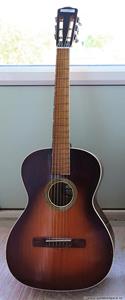
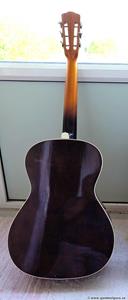









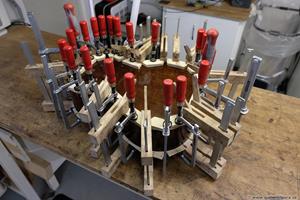

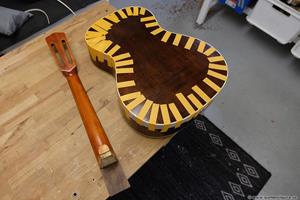







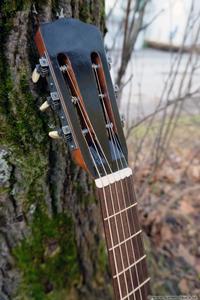
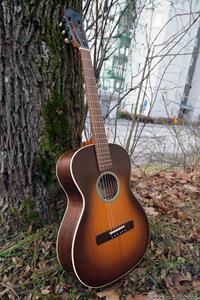



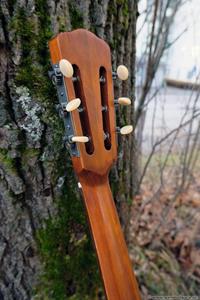
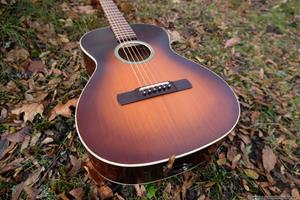

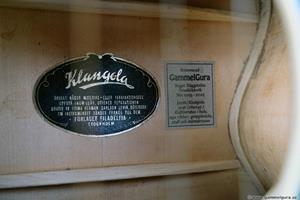


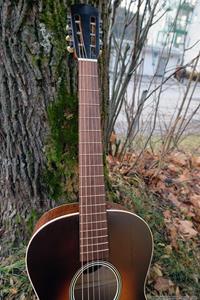

Always fun to follow your work. Nice that you posted some new ones.
Note that you have also tried laying the tone bar across according to Larrivee-stuk. I myself have good experience with that construction. Both in terms of sound and from a sustainability point of view.
Please
Peter D
Didn't know there was a "thing" with that placement. It seems logical and more stable than Martin's slanted ribs.